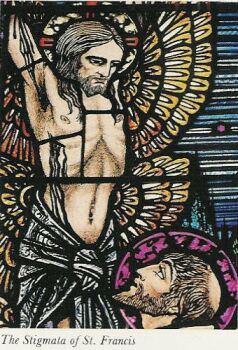Franciscan Friary, Killarney
The New Friary
 |
The architect of the new Friary was Edward Welby Pugin, eldest son of the more famous Augustine
Pugin, the architect of Killarney Cathedral. Work soon started and on the feast of St Patrick, 1864,
Dr. Moriarty laid the foundation-stone of the Church. The stone, taken from the ruins of Muckross
Abbey, was carried through the streets of Killarney by young boys wearing the Franciscan habit,
in memory of an old tradition of the way in which the foundation-stone had been laid at Muckross
four centuries previously. This procession, in which the Bishop, priests and religious of the area
took part, was the first such public religious display in Ireland since the Reformation.
The following year, the site was cleared for the Friary itself. Many people from the Killarney
district lent a willing hand in digging, excavating, levelling and other needed labour, all without
remuneration. During one week, more than two hundred men were engaged in such generous work. The
ideal of the preceding years was fast becoming a reality.
|
Then tragedy struck. Fr. Patrick died on Easter Sunday, 16th April, 1865. He was a mere 38 years old.
This deeply grieved the small community and all who had grown to love this ardent and selfless priest.
Dr. Moriarty likewise sincerely regretted his passing, and wrote an appreciation of him in his diary.
The Bishop asked the friars that, as a favour, they might allow Fr. Patrick to be buried from his
Cathedral, a wish the friars were glad to grant. After the Solemn Requiem and Absolution the funeral
procession wended its way through the town to the unfinished Friary Church where a special crypt had
been prepared in the Sanctuary. There, amid scenes of genuine sadness, Fr. Patrick Verherstraeten was
laid to rest on the 18th April, 1865.
The Grand Bazaar
Fr Arsenius Mertens succeeded as Guardian and continued the work so valiantly begun by Fr. Patrick.
Fund raising was an essential activity at this time and the usual methods were employed. One of the
most successful events was the Grand Bazaar held, at the Guardian's request, by Lord and Lady Castlerosse
"in their pleasure grounds". The two-day event opened on the 21st August, 1866, and throughout the day
bands, including the Kerry Militia, played a selection of airs. The attendance was very large and
festive. Among the notables present were King Leopold II of the Belgians, the Duchesse d'Aumale, the
Comte de Flandres, the Comte de Paris, the Duc de Chartres, the Earl of Kenmare, Lady Kenmare and the
Bishop of Kerry, Dr. Moriarty. The Bazaar realized £1,400 stg., a very satisfactory sum for those days.
The Church of the Most Holy Trinity
Towards the end of July, 1867, the church was ready for use and a triduum was begun in preparation
for the opening. On the feast of the Portiuncula, 2nd August, at 11 a.m., Solemn High Mass was
celebrated. During this Mass Dr. Moriarty preached what the Friary chronicler described as "a most
eloquent and impressive sermon". The liturgical life of the Friary had begun.
It was not until the following year, on the l8th February, 1868, that the church was consecrated. On this occasion,
Dr. Moriarty was assisted by the Bishop of Limerick, Dr. Butler. The church was dedicated to the Most Holy Trinity,
the title of old Muckross Abbey. During this ceremony the relics of the Martyrs of Gorcum were placed in the
High Altar, martyred brethren of these friars from the Lowlands. Thus was the Friary founded on two noble
traditions: Muckross and Gorcum.
The church is simple in style with a lofty arched ceiling and strong oak panelling. Attention is quickly drawn
to the high altar with its ornate details. Flemish in style, it is reminiscent of a former era in church decoration.
It was designed and executed by Mr. J. Janssen of St Trond, Limbourg, Belgium, and was erected in 1871 in memory of
Fr Patrick Verherstraeten, the first Guardian of the Friary. Given prominent niches in the altar are St Patrick and
St Joseph, the patrons of Ireland and Belgium. |
 |
The two side-altars, erected in 1872, are the work of the same Belgian craftsman. It was he who also fashioned the very
fine communion-rail, three years later. This was presented as a gift by the women of Killarney and the surrounding area.
Set in the window recesses are small canvasses featuring various saints, the work of Brother Juniper Arens, a Bavarian friar.
Much more of his work may be seen inside the Friary cloister: wall paintings of Franciscan saints, some notable Irish
Franciscan of the seventeenth century, early Irish friaries, and some intricate scroll work on the arches. An inscription
on one of the walls tells us that this work was carried out between June 1913 and December 1915.

